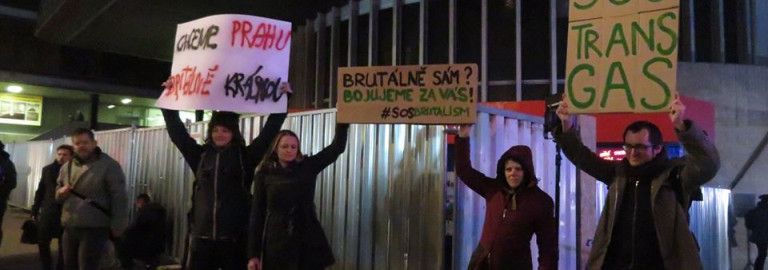
Prague City Hall has been trying last-minute negotiations for the rescue of the Transgas building, located just behind the National Museum. The effort will be an uphill battle, as demolition has started and the two sides are far away on the price.
A rally to save the building, held by the group SOS Transgas, took place the evening of Feb. 20, and attracted some 200 to 300 people. Speakers included representatives of Prague City Hall, Prague 1, Prague 2, the Club for Old Prague (Klub za starou Prahu), academic architecture experts and architect Václav Aulický, who worked on the original complex.
They outlined the issues surrounding the building not receiving landmark protection, despite recommendations from experts, and discussed the place of the building in Prague’s architectural history.
The Ministry of Culture and other authorities were criticized for not protecting the city’s post World War II heritage, especially in terms of buildings and public art.
Developer HB Reavis, which owns the Transgas building, received a valid demolition permit at the start of February and has already knocked down part of an entryway and ripped up some of the concrete including part of a large fountain.
Petr Zeman (Prague Sobě), chairman of city’s territorial development committee, said at the rally that the city is attempting to buy the building. “The developer wants a lot more money than Prague can give,” Zeman said.
Talks with the developer have broken down and won’t resume until the city can offer more money. The only option left is for a private partner or the state to help with the purchase price.
The city would move up to 500 municipal employees into the building.
Before the rally, City Hall posted a statement on its website. “First of all, we must say that we are primarily concerned with the preservation of the existing building. Prague has offered the landowner a price that is cost-effective for the city budget but also corresponds to the value of the property. The owner did not go for this offer, so we are looking for other alternatives, such as addressing some private co-investors,” Prague Deputy Mayor Petr Hlaváček (United Force for Prague) said.
Petr Zeman said the building that symbolizes a certain architectural era. “Above all it is in a key location with good transport accessibility. Its internal renovation and the launch of new uses could take place quickly. We would use the building as office space for city officials that Prague residents should be close to,” Zeman added.
Prague Mayor Zdeněk Hřib (Pirates), the city could transfer people from locations where the city now pays high rents. “We are in favor of protecting valuable buildings and, at the same time, we are committed to economic efficiency,” Hřib said.
HB Reavis plans to continue with the demolition regardless of the negotiations.
Demolition should take several months.
The building was constructed between 1972 and ’78 in a variation of the Brutalist style as a control center for the Transgas pipeline. Part of the complex served as the Federal Ministry of Fuel and Energy. Architect Václav Aulický was involved in the design of the Žižkov TV Tower.
The exterior of the buildings are decorated with cylindrical metal rails meant to evoke the idea of pipelines. The courtyard has a large concrete fountain, which has not been functioning for some time.
The interior was filled with abstract decorative elements that were typical of the era.
Developer HB Reavis intends to build seven mixed-use buildings that could be finished as early as 2021. The new buildings are designed by the studio Jakub Cigler Architekti, which also came up with the concept for current renovation of Wenceslas Square.
HB Reavis got possession of the location in 2014 from energy company ČEZ.
Representatives of the developer have said in the past that the seven new buildings will revitalize the neighborhood. The new complex should include public space with greenery, restaurants, public terraces and barrier-free passage through the area.
